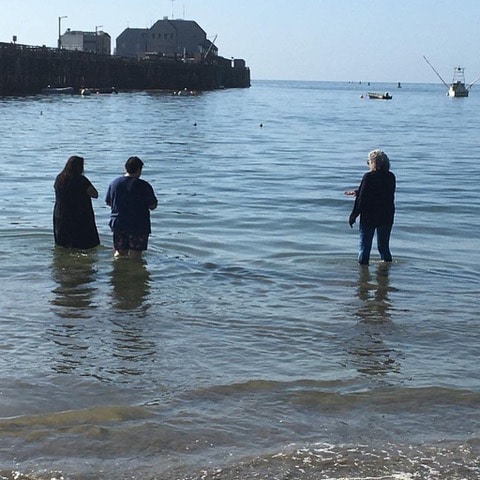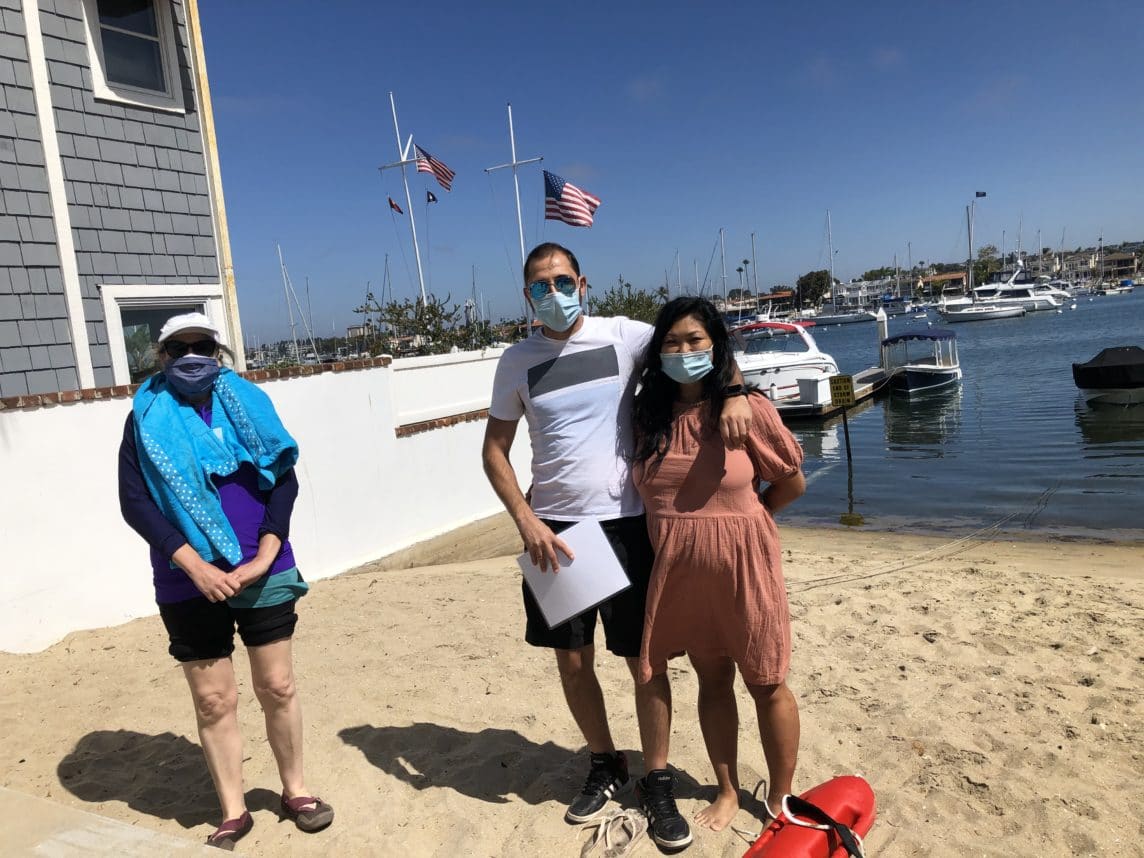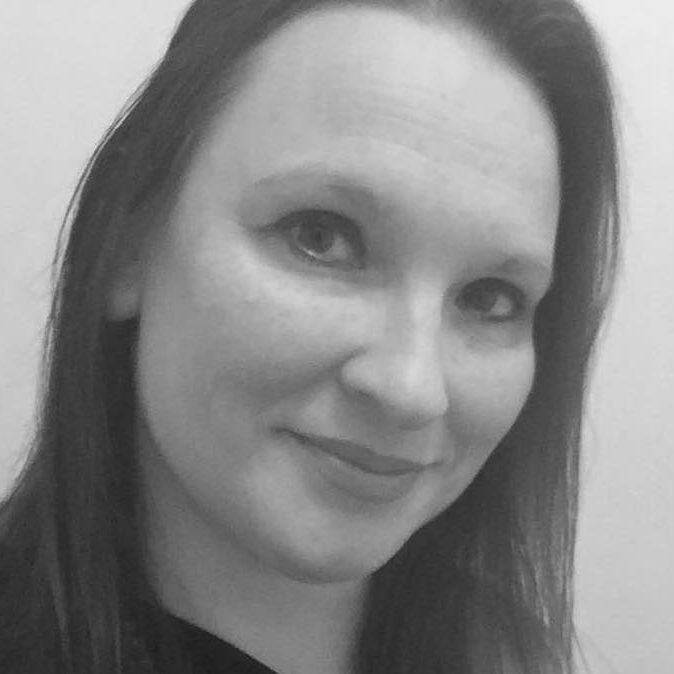 Sidnie Thomas entering the ocean with her partner, Rabbi Janice to the right, at San Luis Obispo Bay, July 12. Courtesy of Sandra Caplan Community Bet Din
Sidnie Thomas entering the ocean with her partner, Rabbi Janice to the right, at San Luis Obispo Bay, July 12. Courtesy of Sandra Caplan Community Bet Din The process of converting to Judaism is an intense journey that includes deep study and taking on Jewish customs and traditions. At the end of that preparation, candidates go before a beit din, a group of three rabbis who assess the candidate. Then comes what is, for many, the most emotional part of the process: immersion in a mikveh — a ritual bath that adheres to certain rabbinic requirements. But due to safety concerns regarding COVID-19, today’s conversion candidates have a natural immersion option: using a natural body of water as a mikveh.
To ask how the ocean fits the requirements for mikveh is “looking at it backward,” said Rabbi Stephen Einstein, founding rabbi emeritus of Congregation B’nai Tzedek in Fountain Valley, who also is on the governing board of the Sandra Caplan Community Bet Din (SCCBD).
“In the days of the Bible, immersion was used as a form of ritual purification,” Einstein said in a joint Zoom interview with Muriel Dance, the SCCBD’s executive director. “People went into a natural body of water. The mikveh was created for people who didn’t have access to natural water, or where waters were very cold. We have had [mikvehs] going back thousands of years,” he said, “but as a replacement for the natural. [Now] we’re going back to the sources.”
Because most oceans and seas are considered to be mikveh-worthy in that they are naturally occurring water, the SCCBD is guiding conversion candidates to natural tevilah (immersion) in Newport Beach and San Luis Obispo.
“Ocean tevilah is a different experience by the very nature of it,” Rabbi Janice Mehring of Congregation Ohr Tzafon in Atascadero told the Journal in an email interview. “We have to consider tide, wind, wave and swell size in order for the tevilah to be safe.”
Einstein said he discovered the Newport Bay location as a natural tevilah spot “before the former UJ (University of Judaism, now the American Jewish University, or AJU) built their mikveh,” and because “those of us who didn’t have a mikveh available outside the Orthodox world had to use a natural body of water.” The spot is private, on the bay side and “very calm,” he said.
During natural tevilah, Einstein and Dance explained, candidates are naked under a one-piece garment that is removed in the water. As with all mikveh experiences, the candidates have showered and removed everything else — rings, piercings, nail polish and shoes — before they immerse. A family member is present to hold the garment during the immersion and to wrap them in a towel after they’re done. And two witnesses, required by Jewish law, are at a 6- to 10-foot distance and wearing masks.

The SCCBD is assessing additional beaches in the South Bay as potential future immersion locations, Dance said, and approving “tevilah sponsors” — people who have gone through their training protocol and would be there to witness immersions, including Einstein and Rabbi Marcia Tilchin in Newport Beach and Mehring in San Luis Obispo.
Jan Souk, who immersed in Newport Bay, called her experience “wonderful. After a few dips, the water became very warm. The rabbis are the sweetest people I have met. They made me feel safe and welcome. When they began to sing to me, I teared up … it was one of the most beautiful experiences of my life,” she told the Journal in an email.
“I just wanted to do whatever would be halachic and possible as soon as possible,” said Hadley Sorsby-Jones, who immersed in Newport Bay last week, with her sponsoring rabbi, Susan Goldberg, and Sorsby-Jones’ partner as witnesses. The other members of her virtual beit din were present at a distance, she told the Journal.
“It was a really positive experience,” Sorsby-Jones said. “Rabbi Susan driving all the way from Los Angeles added a lot to the ceremony. I enjoyed the natural water, and it was celebratory to be finally Jewish.”
“Ocean tevilah (immersion) is a different experience by the very nature of it. We have to consider tide, wind, wave and swell size in order for the tevilah to be safe.” — Rabbi Janice Mehring
“It was a beautiful experience to walk into the living waters of the Pacific Ocean with Hadley,” Goldberg, founder of Nefesh, told the Journal. “In these ever-changing times, to enter into the water with ancient blessings and to witness the open-hearted commitment to becoming a Jew was breathtaking. I was honored to be alongside her even in the chilly waters.”
Although many candidates may choose to use the AJU community mikveh after COVID-19 restrictions are lifted, natural tevilah may remain an option for future conversion candidates, Einstein said.
“We all agree that the mikveh is better, the first choice by far,” he said. “But until that is feasible, we need an alternative because people have been waiting a long time, have weddings or babies coming up. It’s a time issue; we had to move forward.”
“Logistics, time and cost all factor in but the overarching reason for the choice is that candidates want to immerse in the natural waters of the ocean as part of their conversion experience,” Mehring said. “I grew up in San Diego spending nearly every summer day in the ocean, so natural tevilah feels like a perfect place for me to be a witness. The water is cold but the experience is joyful and invigorating enough so that we often don’t want to get out when we are done.”
Mehring is a presiding rabbi at the Atascadero branch of the SCCBD, the only standing pluralistic community beit din in the United States. The SCCBD also has branches in Newport Beach and Ventura, with 132 rabbis across its three branches who hail from all liberal streams of Judaism as dayanim (judges). Dance said that the beit din has, to date, completed 630 conversions. The SCCBD also transitioned to a virtual beit din over Zoom, which Einstein called “a pretty good idea and avoids a lot of time on the freeway. We tried it and it worked out great.
“When someone becomes Jewish, they might choose to affiliate with any synagogue … that’s the choice of any Jew,” he added. “But they’re not converting to Conservative or Reform Judaism; they’re becoming part of am Yisra’el. We all stood at Sinai, and to have a beit din that represents that to the best of our ability is a wonderful idea,” he said, crediting the late Rabbi Richard Levy and Rabbi Elliot Dorff for their roles in founding the SCCBD.
Said Einstein, “We’re saying to each person, ‘You’re part of the entire Jewish people.’ That’s our philosophy.”





















 More news and opinions than at a Shabbat dinner, right in your inbox.
More news and opinions than at a Shabbat dinner, right in your inbox.